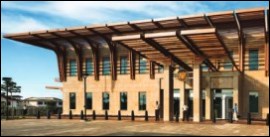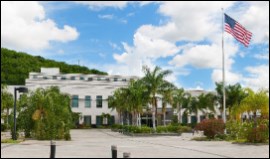by Brianna Crandall — July 9, 2014—The U.S. Department of State’s Bureau of Overseas Buildings Operations (OBO) has opened several new or newly renovated embassies in countries around the world in recent months with exemplary sustainability features, including the first Leadership in Energy and Environmental Design (LEED) Platinum-certified overseas U.S. diplomatic facility; the first building in Burundi to receive LEED certification (Gold); and an energy-savings project that marks the Department of Energy’s first partnership with an energy service company under the Department’s Federal Energy Management Program’s (FEMP) Super Energy Savings Performance Contract (ESPC).
According to OBO, all of the embassies are intended to provide a modern, convenient, and secure workplace for the staff, and all were designed to support the U.S. government’s focus on sustainable facilities. OBO maintains that diplomatic facilities should represent American values and the best in American architecture, engineering, technology, sustainability, art, culture, and construction execution.
Since 1999, as part of the Department’s Capital Security Construction Program, the Bureau of Overseas Buildings Operations (OBO) has completed 113 new diplomatic facilities and has an additional 30 projects in design or under construction.
U.S. Embassy renovation and new chancery in Helsinki, Finland: first LEED Platinum for overseas U.S. diplomatic facility
The new construction and campus renovation allows collocation of all embassy functions and includes construction of a new chancery, access pavilions, and utility space, as well as renovation of the existing office annex to create a new Innovation Center, which houses the embassy’s public offices. The project also renovated the former chancery and the chief of mission residence. Since the 1930s, the Embassy has occupied a three-acre site in the historic Kaivopuisto district of Helsinki.
The annex renovation that provided the Innovation Center is said to be the first LEED Platinum-certified overseas U.S. diplomatic facility. The facility demonstrates strategies to conserve resources and reduce operating costs, including energy savings through natural ventilation, triple-glazed windows, high-performing thermal roof insulation, and city-generated hot water and chilled water that alleviate the need to operate and maintain chillers and boilers; as well as the reduction of water consumption through the use of low-flush and low-flow plumbing fixtures and selected plantings to eliminate the need for permanent irrigation.
The Innovation Center is also the first U.S. diplomatic building to be equipped with 100% LED and organic LED (OLED) bulbs for interior and exterior lighting. The Center is projected to reduce energy costs by 46% from the baseline case (ASHRAE 90.1-2007). The design architect is Moore Ruble Yudell of Santa Monica, California, and the architect of record is PAGE of Arlington, Virginia. This $114 million project was constructed by BL Harbert International, LLC of Birmingham, Alabama.

New U.S. Embassy in Bujumbura, Burundi: LEED Gold certification, first LEED in Burundi
The new U.S. Embassy project in Bujumbura, Burundi, received LEED Gold certification under LEED for New Construction and Major Renovation. It is the first building in Burundi to receive LEED certification.
The facility was designed to reduce energy costs by 52% from the baseline building (ASHRAE 90.1-2004). This was accomplished though architectural shading and a white roof to reduce cooling costs; light-emitting diode (LED) task lighting; occupancy sensors; electric traction elevators; and variable frequency drives for pumps, fans, and motors. Additionally, the embassy yields emission-free power through the use of 960 solar panels, which are expected to produce 453,454 kilowatt hours (kWh) annually.
Furthering the commitment to sustainable design, the facility is projected to reduce water consumption by a calculated 39% from the baseline case through the use of low-flush and low-flow plumbing fixtures. All water used at the embassy is treated on-site and reused for irrigation. The amount of water needed to irrigate landscape plantings is reduced by utilizing plants native to the region.
The design architect is Perkins+Will of Washington, DC, and the architect of record is Einhorn Yaffee Prescott Architecture & Engineering of Albany, New York. The facility was constructed by Caddell Construction of Montgomery, Alabama.

Construction commencement for energy-savings project at U.S. Embassy in Managua, Nicaragua
A new energy-savings project at the U.S. Embassy in Nicaragua marks the Department of Energy’s first partnership with an energy service company under the Department’s Federal Energy Management Program’s (FEMP) Super Energy Savings Performance Contract (ESPC). The project will include the installation of solar photovoltaic panels and lighting upgrades, as well as building automation system optimization, and transformer and chiller upgrades.
The Department has contracted with Lockheed Martin of Rockville, Maryland on this project, which is scheduled to be completed in November 2014. The installation is being executed by Lockheed Martin with institutional financing. The private investment for this project is $15 million. Following installation, the Department will make annual payments based on actual energy savings. Total utility savings is estimated at $36 million over 25 years.





